A system image recovery can be a lifesaver when your computer crashes or you need to rescue an ailing Windows operating system. But what is a system image recovery, and how do you perform one? This complete guide will tell you everything you need to know.
What Is a System Image Recovery?
A system image recovery is the process of restoring your computer from a system image. A system image is a complete copy of your PC, including the operating system, applications, settings, and all your files. If you're having trouble starting Windows, or if your PC has been damaged by malware or a hardware failure, you can use a system image to restore your PC to an earlier state when you created the system image.
System image recovery is different from resetting your PC or reinstalling Windows. When you reset your PC, it will remove all of your files, settings, and apps - essentially returning your PC to its factory default state. When you reinstall Windows, it will keep your files and settings, but any apps that came with your PC or that you installed from the Microsoft Store will be removed.
LEARN MORE
Still befuddled by the system image recovery and reset/reinstall Windows? Here's a full guide on system image recovery vs. system restore.
[Important to Know] What Are Other System Recovery Options in Windows?
In addition, you may have heard other similar terms to system image recovery, for example, a recovery USB drive, a system repair disc, and a system restore point. Do you know what each term means? Here we'll try to use simple words and a comparison table to help you understand.
Option 1. A Recovery USB Drive
A system image recovery requires a separate drive that contains the backup image. The drive can be an external hard drive, a USB flash drive, or a network location. Therefore, a recovery USB drive is a bootable drive that contains a system backup image in it, with which you can reinstall Windows or troubleshoot common Windows problems by booting into Windows Advanced startup options.
Option 2. System Repair Disc
A system repair disc is a bootable CD/DVD disc that contains the Windows Recovery Environment. It can be used to access system recovery options, troubleshoot and fix errors in Windows, and restore your system to a previous state.
You can create a system repair disc in Windows 7 and use it to recover your system. In Windows 8/10/11, you don't need to create a system repair disc because you can access the recovery options directly from the Advanced Startup Options menu. Or, through a recovery USB drive.
How to Restore System Image Without Repair Disc
If you are worried about whether you can restore system image without repair disc, it is possible. In this post, we will see a professional backup tool, EaseUS Todo Backup to create a system image on an external device and use it to restore it on your device.

Option 3. System Restore Point
A system restore point is a snapshot of your system's state at a certain point in time. It can be used to revert your system to a previous state if something goes wrong.
You can create system restore points manually or set Windows to create them automatically on a schedule. To perform a system image recovery, you'll need to use the backup image file that was created at the same time as the system restore point.
| Comparison | Storage Device | What Does It Contain | How to Use It |
|---|---|---|---|
| System Image Recovery | Local drive, network, NAS, cloud | Many system restore points | Restore the operating system and data from it |
| Windows Recovery USB Drive | A USB flash drive, external hard drive | The Windows recovery environment | Boot from it to reinstall the operating system or fix errors on the current PC |
| System Repair Disc | CD/DVD disc | The Windows recovery environment | Boot from it to reinstall the operating system or fix errors on both the current and new PCs |
| System Restore Point | Local drive, network, NAS, cloud | A snapshot of your system state | Use the System Restore feature |
To sum up, if you want a hassle-free system image recovery on a computer, the best combination is to regularly create a system image backup of a working system state on a recovery USB drive or a system repair disc.
Another important note for you: System image recovery will overwrite your system drive, which means you will lose all the files that were created after the system image was created. So if you have any important files on your system drive, make sure to back them up before you proceed with system image recovery.
LEARN MORE
Still feel hesitant? Find answers to "Will system recovery delete my files?" in the linked article.
Walkthrough: How to Perform System Image Recovery
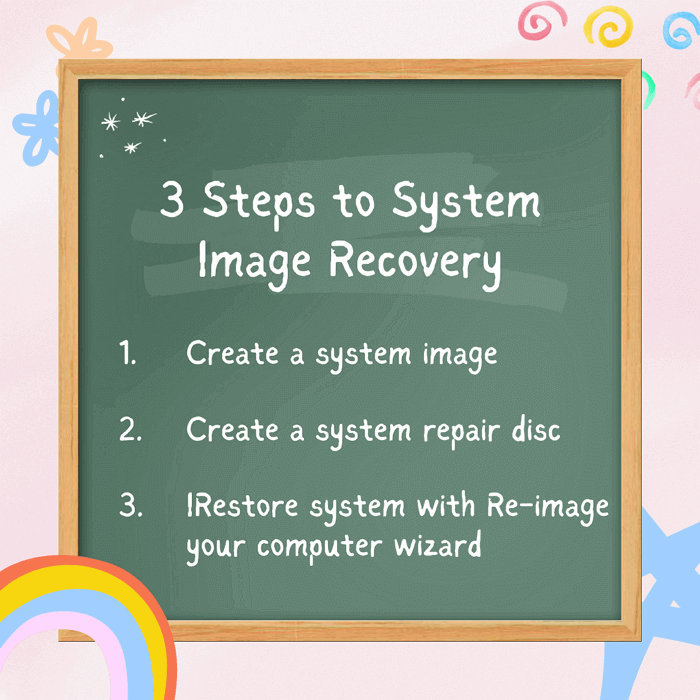
[Image: A flow chart to complete the system image recovery]
Now that you know what system image recovery is, it's time to learn how to do it. According to the flow chart to complete a system image recovery on your PC, there are four steps you must go through, and we must ensure each step is done accurately.
🚩You may be interested: Surface Recovery Image: How to Download & Create & Use
☟Set Up Backup
As we mentioned above, the system image is created from an earlier system state backup. Therefore, the first step is to create a system image backup of your computer using a system image recovery tool. Microsoft Windows has already had a default option called Windows Backup and Restore (Windows 7) within the operating system. Since it's free and handy, it's worth giving it a try.
- Notice:
- There are two default backup and recovery programs in Microsoft Windows. One is called File History, and the other is the older backup option called Windows Backup and Restore (Windows 7), which is firstly introduced in Windows 7 but still works perfectly in Windows 10 and 11. Windows 10 File History backs up only individual files/folders associated with user accounts, while the older solution supports backing up an entire operating system, which happens to be the native system image recovery tool we'll put in use as tutorial material.
Here we take Windows 10 as an example. If you're using another Windows system, don't worry, the steps are very similar. Just follow along.
Step 1. To access the default Windows system image recovery tool in Windows 10, choose one of the paths to follow:
- Open Settings (Windows + I keys) > Update & Settings > Backup > Go to Backup and Restore (Windows 7).
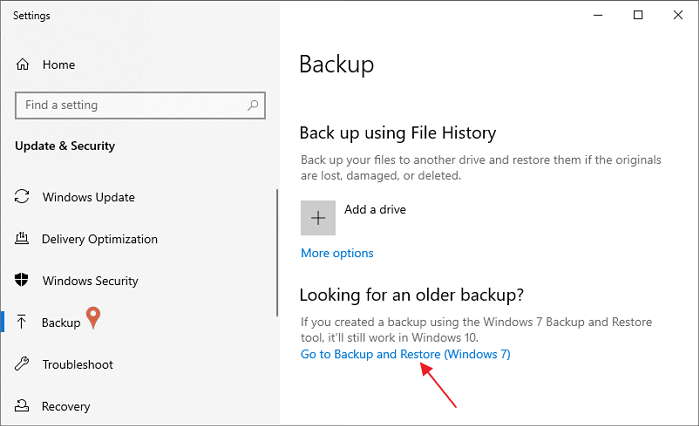
- Open Control Panel (Press Windows key + R then type: control then hit Enter) > Backup and Restore (Windows 7).

Step 2. If you didn't create any backups before, the Backup status should be "Windows Backup has not been set up". You can directly click the "Set up backup" link to start the first backup creation. Or, you can click on "Create a system image" from the left sidebar as instructed here, which will guide you to select a storage location in the first place.
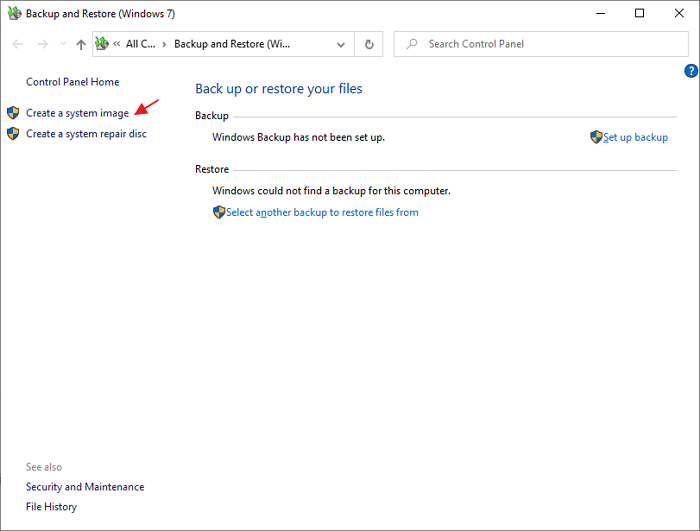
Step 3. There are three backup locations for you to choose from: On a hard disk, On DVDs, and on a network location. Select any one of them that you have at hand. Click Next after selecting the backup destination.

Tip: Which backup location works the best for me?
- Choose a local hard disk/external drive: When you demand a very high frequency of backup of the changed operating system, files or applications. (Note: To create a system image of a drive, it must be formatted to use the NTFS file system. If you save the system image on a hard drive or USB flash drive, it must be formatted to use the NTFS file system.)
- Choose DVDs: If you're backing up system images for the first time or don't have an external hard drive, you can use DVDs. Just make sure you have enough blank DVDs on hand because a system image can be very large, and one DVD can hold only 4.7GB of data.
- Choose a network drive: If you're doing system backups of working computers in a company, and there is network drive available to you, you can try to save the primary backup images on network. To be able to use network drive as a backup location for the first time, you need to enter the network location in the format of "\\server\share and the username and password.
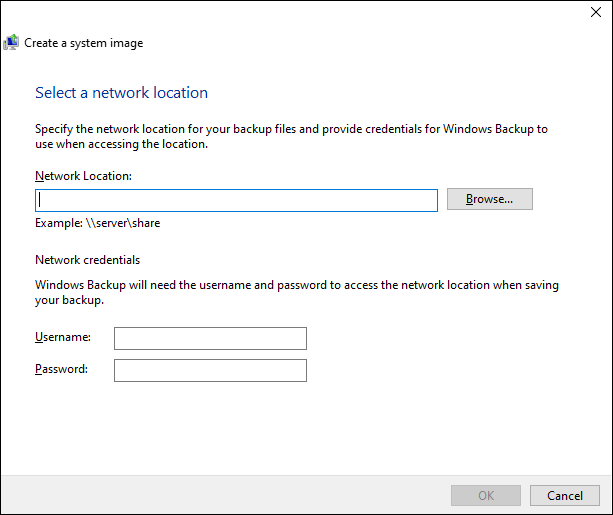
Here I chose a local drive to keep the system image, as an example.
Step 4. Since you're doing a backup of the operating system, the drives that are required for Windows to run will be included by default. As you can see from the screenshot, my system C drive and a system reserved drive is chosen by default and marked as grey (unchangeable).
Pay attention to the important notes here: (1) You cannot include the drive that you're saving the backup to; (2) You can add additional drives in the backup as well, like drive D or E to backup an entire computer; (3) The system image file can be large (as you can see my system drive takes up 90GB space) and therefore it's suggested that you back up system image to an external hard drive with enough storage space. You can find 1TB or 2TB external hard drives on best buy for under $100.
Click Next to continue.

Step 5. Review the backup settings and click Start backup to start system image creation immediately or schedule a system backup in the future. You can also click Change schedule to modify the system image backup interval according to your needs.
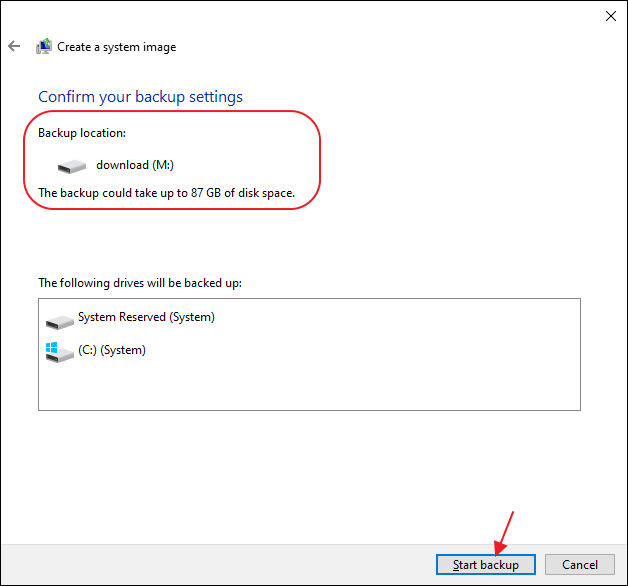
Step 6. Now Windows is saving the backup according to your setup. Wait patiently until this process is complete.
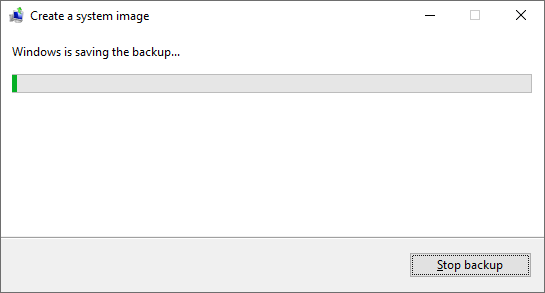
How to Keep Different Versions of System Images
You can keep several versions of system images. On internal and external hard drives, older system images will be deleted when the drive runs out of space. To help conserve disk space, delete older system images.
If you're saving your system images in a network location, you can only keep the most current system image for each computer. System images are saved in the format of drive\WindowsImageBackup\computer name\. If you already have a system image for a computer and are creating a new one for the same computer, the new system image will overwrite the old one.
If you want to keep the old system image, you can copy it to a different location before creating the new system image by following these steps.
- Navigate to the location of the system image.
- Copy the WindowsImageBackup folder to a new location.
LEARN MORE
Do you know that 67% of people choose to create a system image on a USB flash drive? Check the article for reasons and benefits.
☝Create a System Repair Disc (for Bootable Recovery)
After the backup task is completed, Windows will guide you to create a system repair disc to use if your computer ever permanently shuts down and couldn't turn on anymore. And you mustn't skip this step, it's quite important and necessary.
Technically, to perform a system image recovery, the essential requirement is a system image. However, when you save a system image backup on a local disk, external drive or a network drive, it's no problem to access it when your computer can turn on as usual. What if the system crashed and you lost access to the image? In fact, in over 80% of the cases, it's because your PC ran into a problem and cannot boot, you need to revert the system back to a working state.
A system repair disc, originally introduced for Windows 7 but still accessible in later Windows versions, can be used to boot your computer when the system abnormally shuts down. It can help you troubleshoot and repair serious problems that might prevent Windows from starting correctly. You should create a system repair disc and keep it handy in case your computer doesn't start correctly and restore it to a working state by performing a system image recovery via such a bootable disc.
(Windows 8.1/10/11 users can create a Window recovery USB drive instead of a system repair disc)
To create a system repair disc in Windows 7/8.1/10/11:
Step 1. Go to Start > Control Panel > Backup and Restore.
Step 2. On the left side, click Create a system repair disc. If a User Account Control message appears, click Yes to continue.

Step 3. Choose the CD or DVD drive where you want to create the system repair disc, and then click Create disc.

Step 4. The system will now burn a system repair disc for you, wait until the process is completed.
Step 5. When the system repair disk is created successfully, click Close to finish.
Now you can keep this system repair disc in a safe place, it can be very helpful when system image recovery is required.
☝ Restore PC from a System Image
Now we arrive at the critical procedure to finally recover Windows from a system image. We need to restore an operating system for many reasons. The system could be crashed by a virus or system file damage, it could also simply be because you installed too many unnecessary programs and bloatware that make the system run slow. No matter what the reasons are, as long as you have a system image backup created in advance (and we strongly suggest you should), a system image recovery is always an option.
We'll show you how to perform system image recovery in Windows 11/10/8.1/7 step by step. The interface may look a little bit different if you're using an older Windows version, but the procedures are actually quite similar.
(Note that system image recovery will restore everything you backed up to an earlier state. It's not for some individual file recovery. Use data recovery software to recover deleted files instead.)
Step 1. Launch system image recovery on your PC. The entrance can be different according to your current computer's state.
- Case 1: Your computer can still turn on.
Go to Settings > Update and Security > Recovery. Under Advanced startup, click "Restart now".

- Case 2: Your computer failed to boot and you need to use a system repair disc.
Insert the system repair disc into your CD/DVD drive, then restart your computer. Connect your external hard drive containing the system image backup.
Step 2. Both operations will bring you to the "Choose an option" screen. Follow the path to select Troubleshoot > Advanced options > System Image Recovery.

Step 3. System image recovery will now scan all system images on all available drives and display them in a list. Select the most recent system image and click "Next".
Step 4. Confirm the operation. You'll be warned that system image recovery will delete everything on your hard drive and replace it with the selected system image backup. Click "Finish" to continue.
Step 5. The system image recovery process will now start, and you'll see the Re-image Your Computer Wizard window appears. First, select a system image version to restore. Windows recommends using the latest available system image by default, as the below image shows. Click Next to continue.

Step 6. Next, you need to choose additional restore points.
- Format and repartition disks: If you're restoring to a new hard disk, it's better to enable this option.
- Exclude disks: If you have multiple hard drives and don't want to restore system image backup to all of them, select the drives that you want to exclude from the restore operation.
- Advanced settings: Configure additional options for system image recovery. You can also change where Windows will search for the system image backup files. If your system image is stored on a network location, select that option.

Step 7. On the next screen, you'll need to confirm the operation. Windows will warn you that system image recovery will delete everything on your hard drive and replace it with the selected system image backup. Click Finish to continue.
Step 8. The system image recovery process will now start, and you'll see the progress bar appear on the screen. Depending on the size of your system image and the speed of your hard drive, this process can take a while to complete.
After system image recovery, Windows will restart automatically and boot up from the system image you just restored. You can then check if the problem has been fixed and your computer runs as usual. If system image recovery doesn't work as expected or you can't boot into Windows, try other methods in this guide.
Problem: Failed to Perform a System Image Recovery on My PC
If you see error messages or system image recovery failed to work, it's likely that the system image backup is corrupted, or something goes wrong with your backup disk. For example, in Windows 8.1 or 10, you may encounter an error message like "The system image restore failed. The System cannot find the file specified (0x80070002). It's an error telling that the backup image is prematurely dismounted during the restore process.
To be able to recover the system from such an error, follow the below steps.
Step 1. When booting into the Choose an option screen, this time click Troubleshoot > Advanced options > Command Prompt.

Step 2. Now the Command Prompt window opens. Now we'll use the DISKPART command lines to locate the volume where the OS was installed. When you perform system image recovery and meet the error 0x80070002, the system drive will be recognized as RAW. What we're going to fix is to convert RAW to NTFS. Type: diskpart > list volume > select volume x > format fs=NTFS quick > exit.
Step 3. Back to Choose an option, click Troubleshoot > Advanced options > System Image Recovery. Follow the guidance of the Re-image Your Computer Wizard to complete the restore from the backup that you saved.
Other problems that would cause a system image recovery failure can be "Windows cannot find a system image on this computer", or "system image restore failed because of EFI or BIOS errors." Errors akin to the examples here are usually because when you restore a system image to a computer that has different firmware.
LEARN MORE
Due to reasons that the configuration settings and necessary drivers on another computer are usually different from your current PC, to be able to restore a system image to a different computer with dissimilar hardware, you must use the right tools and follow the right restore procedures.
[Highly Recommend] Third-party Windows System Image Recovery Tool
Now you got the whole procedure of creating a system backup image, and the detailed instruction on how to restore a PC from a system image. In addition, how to use a system repair disc to recover an unbootable computer. To some degree, the default Windows system image recovery tool is user-friendly for most computer users, and it can be a basic backup plan for individuals. As for advanced use, for example, to encrypt a system image, compress a system image into small size to save disk space, or set up an automatic backup frequency, it's far competent enough.
Alternatively, EaseUS Todo Backup is a a more complete and professional system backup and recovery solution than the inbuilt tool for all editions of Windows 10/8.1/8/7, such as Home, Professional, Enterprise, and so on. It's exclusively designed for Windows users who're looking for a simple, fast and worry-free system protection plan.
Unlike the built-in system image backup tool in Windows, EaseUS Todo Backup can create a system image and store it on an external hard drive, USB flash drive, network share or cloud. It also supports scheduled system image backup so that you can set up an automatic system image backup plan to protect your PC.

In general, below are reasons why more and more users choose third-party system backup and recovery software over the default Windows system restore program. Check the key points one by one.
- Less chance of failing to create a system backup or perform a recovery
- Much simpler and more intelligent in doing backups, and the recovery speed is faster.
- Supports system backup to external hard drives, USB flash drives, network locations, NAS and cloud storage. Enable users to create one more copy of backups in different locations at the same time.
- Allows you to schedule system image backups daily, weekly, monthly, or upon an event.
- Doing an incremental and differential backup to greatly improve the recovery speed and disk space usage.
- Advanced backup options to let you compress, encrypt, merge and split backup images for flexible system management.
- Integrated with the hot feature of cloning hard drive, which is very useful when you want to upgrade your system disk to a larger one.
- Creating a bootable rescue media is much easier than creating a system repair disc in Windows.
- Allows to create and restore a system image to another computer without booting problems.
- 24X7 tech support via live chat, email, and phone calls. Remote assistance is available.
Now, let's see how to create a system image backup and recover your system with EaseUS Todo Backup.
Secure Download
Backup System Image:
Step 1. Launch EaseUS Todo Backup on your computer, and click Create Backup on the home screen and then hit the big question mark to select backup contents.

Step 2. To back up your Windows operating system, click "OS" to begin the backup task.

Step 3. Your Windows operating system information and all system related files and partitions will be automatically selected so you don't need to do any manual selection at this step. Next, you'll need to choose a location to save the system image backup by clicking the illustrated area.

Step 4. The backup location can be another local drive on your computer, an external hard drive, network, cloud or NAS. Generally, we recommend you use an external physical drive or cloud to preserve the system backup files.

Step 5. Customiztion settings like enabling an automatic backup schedule in daily, weekly, monthly, or upon an event, and making a differential and incremental backup are available in the Options button if you're interested. Click "Backup Now", and the Windows system backup process will begin. The completed backup task will display on the left side in a card style.

Restore a System Image:
* To perform system recovery on a none-bootable machine, try to boot the computer through the EaseUS Todo Backup emergency disk.
Step 1. Launch EaseUS Todo Backup, click "Browse to Recover".
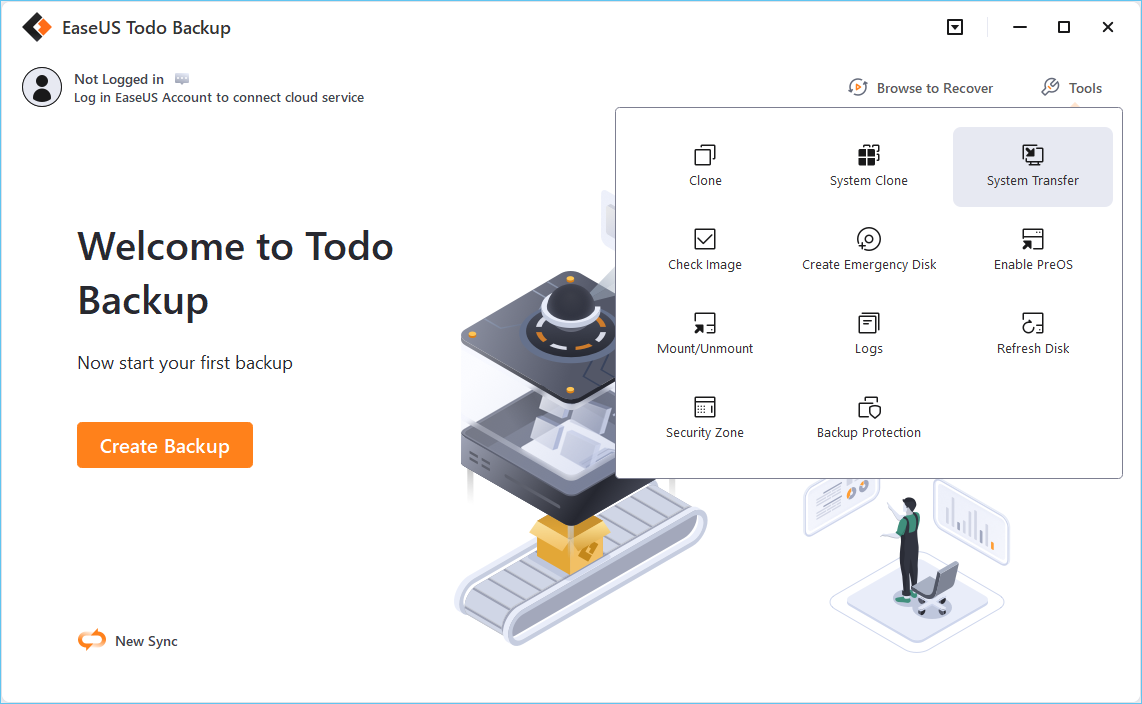
Step 2. Guide to your backup destination, choose the system backup file you need. (The backup file created by EaseUS Todo Backup is a pbd file.)
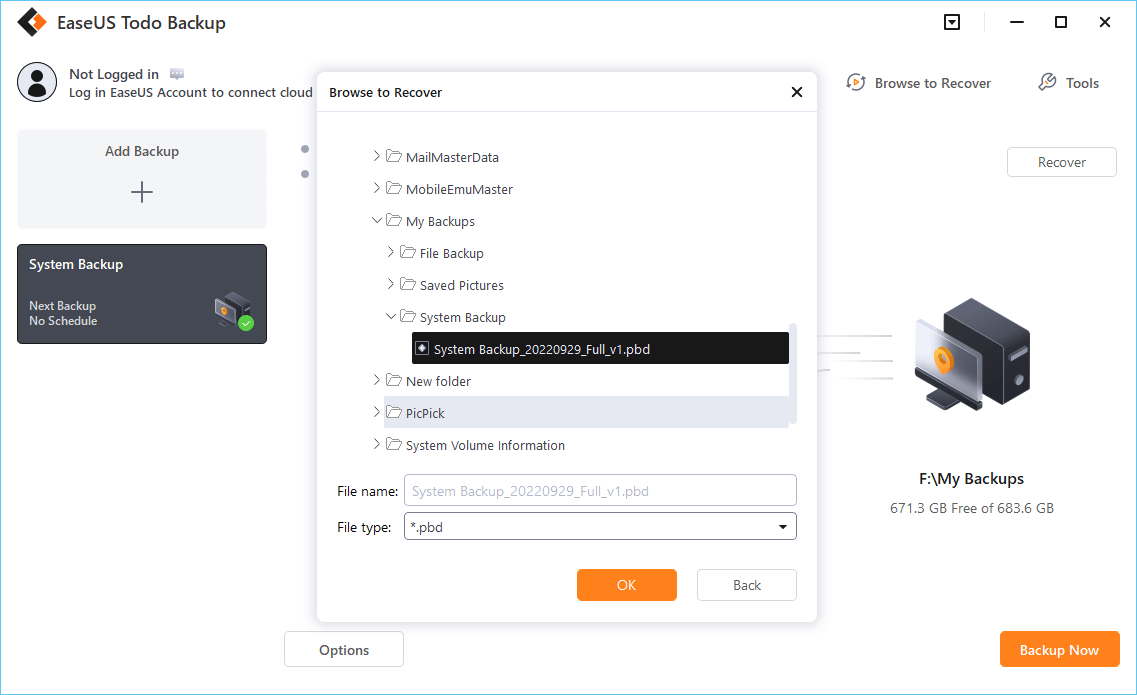
Step 3. Choose the recovery disk. Make sure that the partition style of the source disk and the recovery disk are the same.
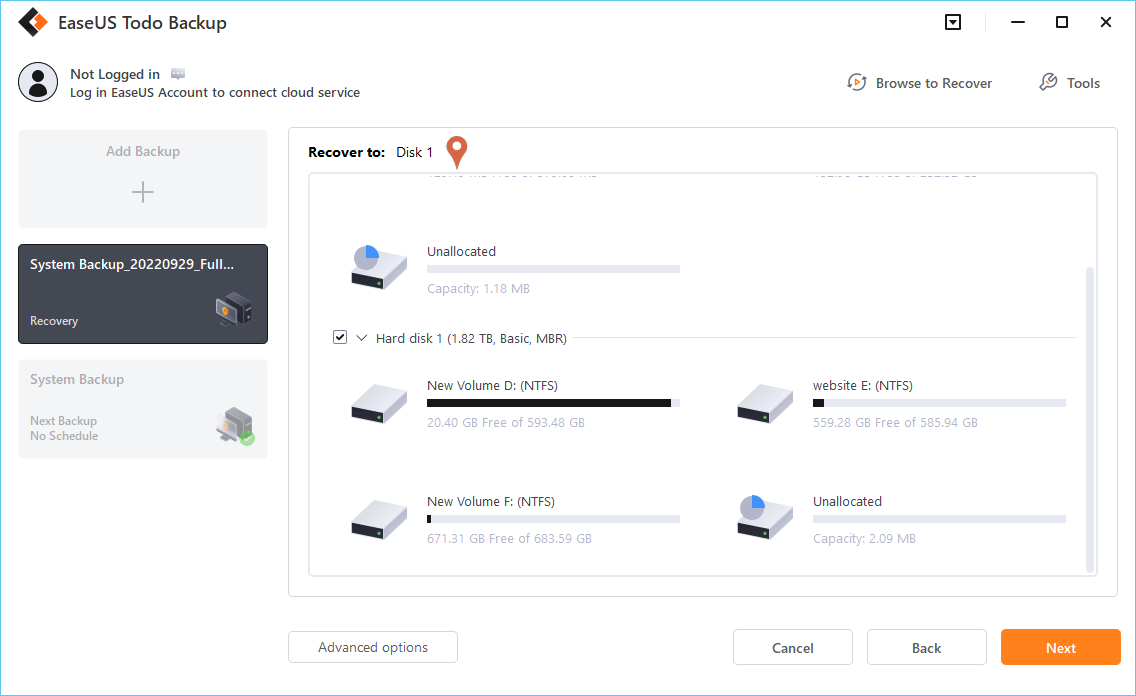
Step 4. You can customize the disk layout according to your needs. Then click "Proceed" to start system backup recovery.
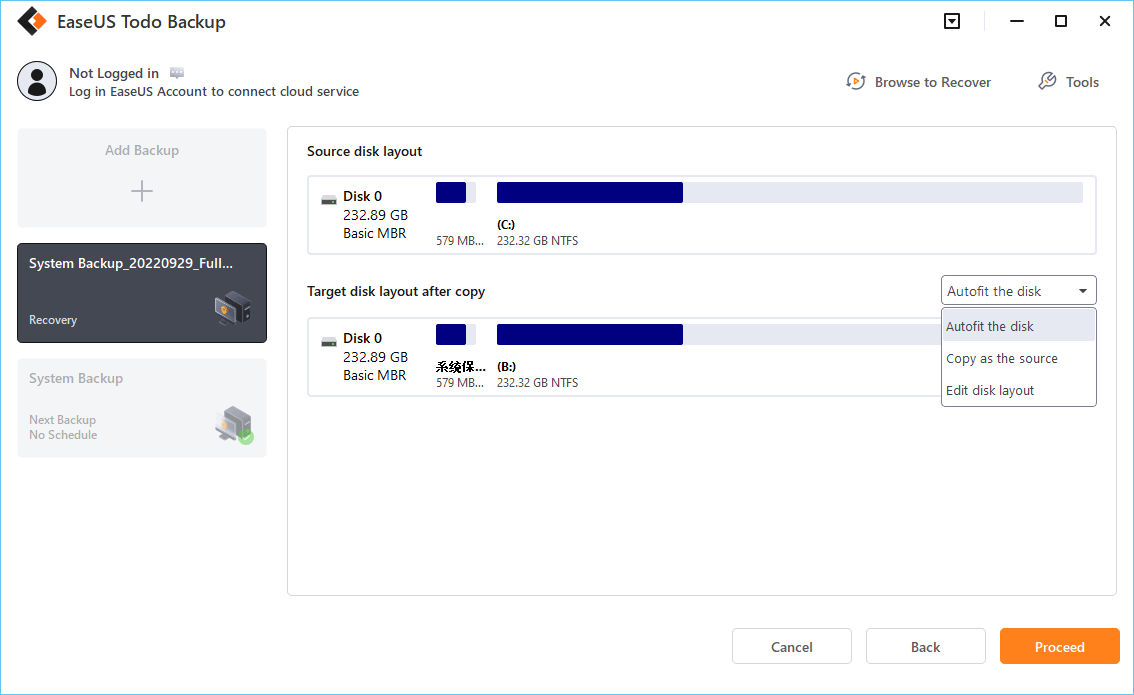
LEARN MORE
Besides EaseUS Todo Backup, check the list of top 5 best Windows backup software that enables you to create a useful system image and perform a system image recovery on both your current PC and new PC.
Key Takeaways for a Successful System Image Recovery
- A system image is a complete copy of your computer's system drive, which contains your operating system and all of your installed programs and settings.
- The goal of system image recovery is to restore your computer from a system image backup in case of system failure or data loss.
- To perform system image recovery, you must create a system image in advance.
- There are two ways to create a system image backup: using the built-in system image backup tool in Windows or using third-party system backup software.
- Before you start system image recovery, check if your computer can normally start or cannot. If it's unbootable, try to boot it through the system repair disc you created and then select the system image to recover.
- If system image recovery doesn't work as expected or you can't boot into Windows, try EaseUS Todo Backup in this guide. Here are the top 10 reasons to download EaseUS backup and recovery software.
Secure Download
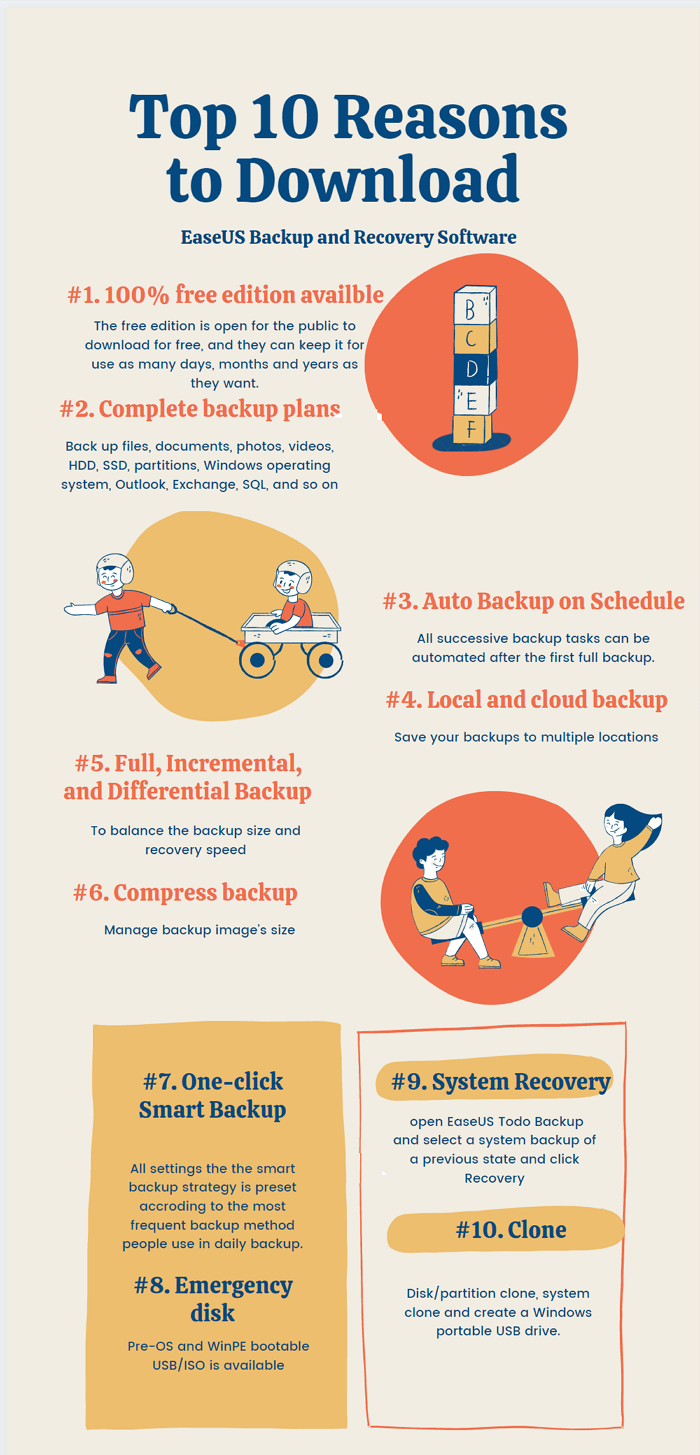
Was This Page Helpful?
Updated by Jerry
"I hope my articles can help solve your technical problems. If you are interested in other articles, you can check the articles at the bottom of this page, and you can also check my Facebook to get additional help."
Jean is recognized as one of the most professional writers in EaseUS. She has kept improving her writing skills over the past 10 years and helped millions of her readers solve their tech problems on PC, Mac, and iOS devices.
Related Articles
-
Beginner's Guide: How to Use File History Windows 10
![author icon]() Jean/Nov 25, 2024
Jean/Nov 25, 2024 -
Overall Guide to Migrate/Move OS to SSD
![author icon]() Jean/May 14, 2024
Jean/May 14, 2024 -
File Backup - 2025 Guide to Understand It Comprehensively
![author icon]() Larissa/Jan 10, 2025
Larissa/Jan 10, 2025 -
(2025) An Ultimate Guide to Backup Hard Drive and Restore Your Computer
![author icon]() Jean/Jan 10, 2025
Jean/Jan 10, 2025